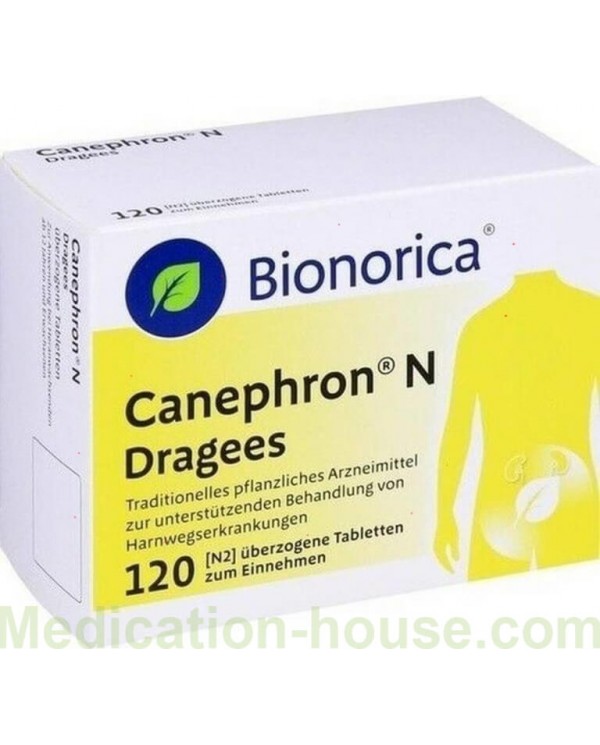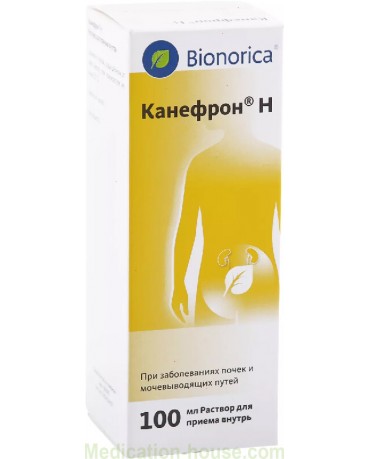Instruction for Canephron N
Reed more and buy Canephron N here
One of the indications for the treatment of Canephron N is inflammation of the bladder. Cystitis can occur primarily or secondary to an infection in another organ. By the nature of the course, this is either an acute process, or turning into a chronic form, when the disease lasts more than six months and is characterized by the presence of remissions and exacerbations. If the inflammation is caused by a specific or nonspecific flora, it speaks for infectious cystitis. In this case, you need appropriate treatment with the introduction of antibacterial drugs. Cystitis caused by chemical, thermal, toxic and other harmful factors is called non-infectious. Without fail, etiotropic therapy will be required, eliminating the cause of the pathology. There are predisposing factors for the development of inflammation of the bladder wall:
injury to the mucous membrane (for example, kidney stones);
congestion in the veins that carry blood away from the pelvis;
imbalance of hormones;
lack of vitamins;
hypothermia;
violation of the process of excretion of urine from the body, stagnation of urine in the bladder.
With infectious cystitis, there are four ways of infection: ascending from the underlying organs, descending from the overlying ones, hematogenous with blood flow from any pathological foci in the body, lymphogenous with lymph flow. The most common causative agent of the disease is E. coli. Women are characterized by such an anatomical structure of the urethra, which predisposes to the development of infections. This leads to a more frequent incidence of cystitis in women. The first symptoms of inflammation of the bladder wall include: - pain in the projection of the affected organ;
discomfort when urinating, more frequent urge up to several times per hour;
subfebrile temperature;
weakness, malaise, weakness;
pain at the end of urination.
For diagnosis and correct diagnosis, they are guided by a typical clinical picture, factors preceding the disease (for example, hypothermia), laboratory and instrumental diagnostic methods. For therapy, non-drug treatment is just as important as taking special drugs. It is necessary to stay in bed, drink plenty of fluids and follow a diet with the exception of spicy, salty foods and alcoholic beverages.
Pharmacological group
Canephron N is a pharmacological agent from the class of herbal diuretics for the complex treatment of diseases of the urinary system. It is used both at the outpatient clinic and at the hospital stage of treatment.
Release form and component composition
Canephron N is available in two dosage forms: - In the form of coated orange dragees. The total number in the package is sixty pieces. - In the form of a liquid solution for oral administration per os. The volume of the bottle is one hundred milliliters. The medicine box contains instructions for use with all the necessary recommendations. The dragee and solution contain as the main pharmaceutical substances: - centaury herb; - the roots of the perennial plant lovage; - components of rosemary leaves. The oral solution also contains Aqua destillata. The dragee contains as auxiliary substances necessary for giving the dosage form: food additive corn starch, silicon oxide (4) colloidal, milk sugar, polyvinylpyrrolidone.
Pharmacological action and pharmacokinetic parameters of a diuretic
Each plant component has its own specific effect on the body. The centaury herb helps to improve appetite, has a choleretic, anti-inflammatory and analgesic effect. Lovage officinalis has expectorant, diuretic and tonic properties. Rosemary leaves also have anti-inflammatory effects on the body. The drug is not used in the treatment of cystitis individually, but only in complex therapy. It increases the effectiveness of taking antibiotics, helps to normalize urination, eliminates pain, and reduces the risk of exacerbations in chronic cystitis. The action of the herbal remedy becomes noticeable not immediately, but only with prolonged use. There is no data on the pharmacokinetic parameters of the herbal remedy, due to its multicomponent nature. Activity is due to the action of all components.
Spectrum of indications for use
Canephron N is used in complex therapy: - Inflammation of the bladder wall. - Infectious chronic nonspecific inflammatory kidney disease with damage to the renal pelvis, calyces and parenchyma. - Glomerular nephritis with damage to the glomeruli of the kidneys. - Chronic tubulointerstitial nephritis with localization in the interstitial tissue and pathology of the renal tubules. It is effective in preventing the re-formation of stones in the urinary system after their removal and in reducing the risk of recurrence in chronic processes in the kidneys and bladder.
Canephron N: a range of contraindications for use for treatment
- Increased individual sensitivity to the main herbal pharmaceutical substances and additional substances necessary to give the dosage form, as well as to the components of the dragee shell. - Peptic ulcer, a local defect in the mucous membrane of the stomach and duodenum, especially in the stage of exacerbation of the process. - For the dosage form in the form of a solution: the child's age is up to one year. - For the dosage form in the form of pills: preschool age. - Lack of an enzyme that breaks down lactose. - Hypolactasia with a decrease in lactase levels. - Malabsorption of glucose-galactose. - Alcohol addiction. - Malabsorption of sucrose-isomaltose. - Intolerance to fruit sugar. The solution should be taken with caution, under the supervision of a treating specialist for: - liver pathologies of class B and C on the Child-Pugh scale;
- craniocerebral trauma; - lesions of the central nervous system.
Side effects of the herbal remedy
- dyspeptic symptoms in the form of nausea, vomiting, pain in the stomach or intestines, constipation, frequent loose stools, functional digestive disorders, excessive accumulation of gases in the intestines; - headache of various localization and severity; - allergic reactions in the form of a rash, accompanied by itching or without it, redness of the skin, angioedema, rarely - anaphylactic shock.
Application of Canephron N: method, features, dose
It is necessary to focus on the dosage prescribed by the treating specialist. The solution is taken orally per os, washed down with the required amount of water. For adults, the recommended dose is fifty drops three times a day. For children over seven years old - twenty-five drops three times a day. For children under seven years old, but over one year old - fifteen drops three times a day. Dragee should be taken orally per os, washed down with the required amount of water and without chewing. The recommended dose is two tablets three times a day for adults. One tablet three times a day for children over six years old. When prescribing the duration of therapy, focus on alleviating symptoms. After the manifestations subside, take the remedy for another month.
Special instructions when using Canephron N
In pediatrics, the drug is used. Dragee for children over six years old, oral solution can be given to children from one year of age. No dosage reduction is required for elderly patients. In case of impaired renal function while maintaining a glomerular filtration rate of more than 30 milliliters per minute, dose adjustment is not required. In case of class A liver pathologies on the Child-Pugh scale, correction is not needed. In patients with more severe damage to these organs, Canephron N should be taken with caution, under the supervision of a treating specialist. Not to be used as monotherapy, but only as a component of complex treatment, including both medication and non-medication: diet, plenty of drink, bed rest if necessary.
With peripheral edema resulting from cardiovascular disease or kidney damage, drinking plenty of fluids is contraindicated. The oral solution must be shaken before use. Since the solution contains ethyl alcohol, one should refrain from driving for the period of the course of therapy.
Use during pregnancy and before breastfeeding stops
It is possible to take a herbal remedy in a dosage form in the form of a pill as directed by a gynecologist and under his constant supervision. There are no contraindications for use during the lactation period.
Canephron N: overdose
There is no evidence of cases of taking doses in greater quantities than recommended in the instructions or in consultation with a specialist. Symptoms are possible, similar to the manifestations from the paragraph about side effects. Treatment is symptomatic. A drug with a specific action that stops or weakening the effect of large doses taken (antidote) has not been developed. Dialysis is not used.
Simultaneous administration of the diuretic Canephron N with other drugs
Complex therapy and the appointment of antibacterial agents in conjunction with Canephron N are necessary. There is no data on the interaction of herbal medicine with other medicines. It is not recommended to consume alcohol during the course of therapy.
Storage conditions
Canephron N requires optimal storage conditions, including items such as: adherence to a dry temperature regime up to twenty-five degrees, use before the expiration date of three years for solution and pills (for an open bottle with a solution, the shelf life is reduced to six months), inaccessibility for children. Do not apply after the expiration date.
Terms of sell
You can buy Canephron N without a prescription.


